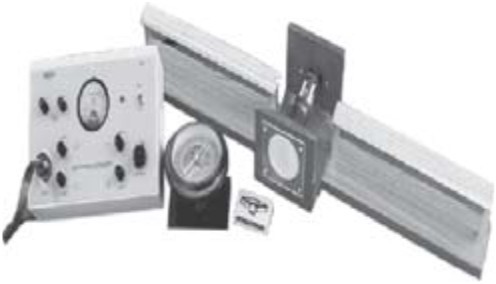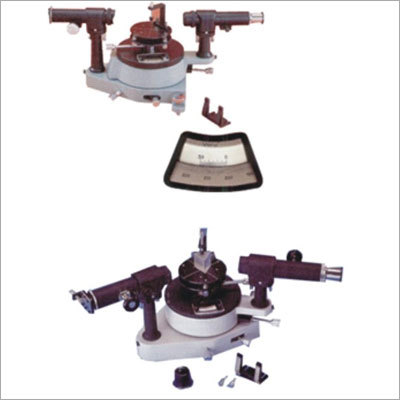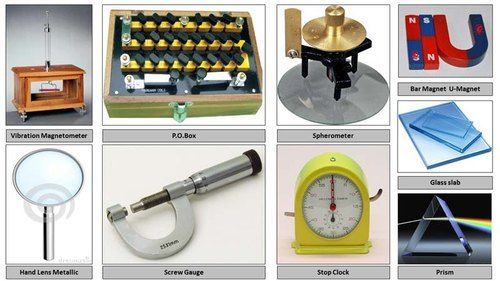e/m By Thomson (Bar Magnet Method)
e/m By Thomson (Bar Magnet Method) Specification
- Feature
- Highly Efficient
- Measurement Range
- Up to 10,000 gauss
- Core Components
- Bar Magnet, Thomson Tube, Power Supply, Wooden Base, Measuring Scale
- Model No
- TSM-EM2024
- Automation Grade
- Manual
- Voltage
- 220 V
- Power Source
- AC Mains
- Frequency
- 50 Hz
- Accuracy
- 100 %
- Temperature Range
- Ambient Laboratory Conditions
- Capacity
- 1 Set
- Equipment Materials
- Metal and Glass
- Type
- e/m Apparatus
- Usage
- Laboratory
- Dimension (L*W*H)
- 45 cm x 25 cm x 25 cm
- Weight
- 8.5 kg (approx)
About e/m By Thomson (Bar Magnet Method)
Activity : To measure e/m of Electron by Thomson Method Bar Magnet method. One method of demonstration modern physics in the controlled bending of stream of high speed electrons in a magnetic field. The actual measurement by students of the ratio of the charge on the electron to its equally minute mass imparts a stimulating sense of achievement. e/m apparatus has been perfected to the point where it is possible for this fundamentally important measurement to be carried out with good accuracy. Power Supply : E.H.T. 800V D.C. for cathode Voltage to C.R. tube. 0-100 volts D.C. with moving coil meters to measure the Deflecting voltage either y1 or y2 Plates.Cathode Ray tube fitted on wooden frame with scale divided in centimeters. Deflecting Magnetometer with permanent magnetic compass included. Compass stand, a pair of Bar Magnet.
Highly Accurate e/m Measurement
This apparatus leverages a meticulously calibrated Thomson tube and a high-quality cylindrical Alnico bar magnet to deliver precise evaluations of the electrons charge-to-mass ratio. The clear, non-fading scale and sensitive needle pointer minimize observation errors, making it ideal for laboratory experiments that demand accuracy.
Designed for Ease and Safety
The polished hardwood support and low-friction pointer ensure both stability and smooth measurement. Overload protection in the built-in power supply safeguards the device and enhances user safety. The inclusion of a detailed operating manual helps streamline the setup for educators and students alike.
Built to Last
Manufactured with durable metal and glass components, this apparatus is engineered for frequent laboratory use. Thermocol packing guarantees safe transport and storage, while clear markings and quality craftsmanship ensure consistent performance across a wide range of practical applications.
FAQs of e/m By Thomson (Bar Magnet Method):
Q: How is the e/m by Thomson apparatus set up in the laboratory?
A: The setup process is straightforwardplace the apparatus on the hardwood stand, connect the 1.5-meter power cable to a 220 V AC mains supply, and carefully position the cylindrical Alnico bar magnet. The included operating manual provides a step-by-step guide to assembling and calibrating all components for accurate experimental results.Q: What is the primary benefit of using a uniformly wound, calibrated Thomson tube?
A: A uniformly wound, calibrated Thomson tube ensures consistent and uniform magnetic field distribution, which is critical for obtaining precise measurements of the electrons charge-to-mass ratio. This minimizes experimental errors and increases measurement accuracy, especially in educational laboratory settings.Q: When should this e/m apparatus be used?
A: This e/m apparatus is ideal for use during laboratory practicals in colleges and universities, particularly for demonstrations and investigations related to foundational physics principles such as electron charge-to-mass ratio determination.Q: Where is the apparatus most commonly used?
A: The apparatus is widely utilized in educational institutionsincluding college and university physics laboratoriesacross India, where accuracy, reliability, and safety are essential for student experiments and demonstrations.Q: What is the process for conducting an experiment with this equipment?
A: Begin by assembling the equipment according to the manual. Insert the Thomson tube, calibrate the bar magnets position, and use the sensitive pointer to record measurements. The clear scale (least count 0.01 cm) allows for precise readings as you adjust the magnetic field and voltage to observe electron deflection.Q: How does the built-in overload protection enhance safety?
A: Overload protection in the power supply ensures that if the current exceeds safe limits, the apparatus is automatically protected from damage. This feature minimizes potential hazards to users and prolongs the lifespan of the equipment.Q: What advantages does the cylindrical Alnico bar magnet provide?
A: The cylindrical Alnico bar magnet produces a stable and strong magnetic field up to 10,000 gauss, necessary for accurate e/m measurements. Its corrosion resistance and durability make it suitable for repeated laboratory use without loss of performance.

Price:
- 50
- 100
- 200
- 250
- 500
- 1000+
More Products in PHYSICS LABORATORY EQUIPMENT Category
SPECTROMETERS, ADVANCED
Usage : Laboratory
Equipment Materials : Stainless Steel, Alloy
Type : Spectrometer
Dimension (L*W*H) : 400 mm x 250 mm x 120 mm
Power Source : Electric
Automation Grade : Automatic
OPTICAL BENCH, METAL ADVANCED
Usage : For optical experiments and physics laboratories
Equipment Materials : Metal construction
Type : Optical Bench
Dimension (L*W*H) : 1200 mm x 250 mm x 150 mm
Power Source : Not required
Automation Grade : Manual
physics lab equipment
Usage : Educational experiments scientific study
Equipment Materials : Various: wood brass glass and metal
Type : Physics Lab Equipment
Dimension (L*W*H) : Varies by equipment
Power Source : None Manual
Automation Grade : Manual
TAPE TIMER
Usage : Physics and laboratory experiments
Equipment Materials : Wooden base metal components
Type : Timer
Dimension (L*W*H) : Standard
Power Source : None
Automation Grade : Manual
GST : 06ACOPS0805K1ZD
|
 |
SINGHLA SCIENTIFIC INDUSTRIES
All Rights Reserved.(Terms of Use) Developed and Managed by Infocom Network Private Limited. |


 Send Inquiry
Send Inquiry





